My second favorite position to play, the Point Guard! I
think the way I play PG is a rarity in FSB these days… I ACTUALLY PASS! I am
not a scoring PG… I just facilitate the offense, play defense, and shoot only
when I am open. With my style, I usually end up getting more assists than
points. My style of playing PG makes me a scorer’s best friend, especially SF. Many
people might think a passing PG is easy and boring to play, but they don’t see
how complicated it can be. By the way, I prefer to play with a SF when I’m PG…
I don’t like to play with SG or scoring PF… this is just my personal
preference, you can play with whoever you want.
I suggest reading the guide before watching the video
SKILLS
***The first 5
skills are required. They're the ones you should equip if you don’t
have extra slots***
***I have 10 slots
each for skills/freestyles on my PG but I don't use them all***
Through pass: this skill is already important but even more
crucial on a PG.
Face up: since you will be guarding a lot of perimeter
shooters, this is definitely needed to stop their jukes or to get past screens.
Diving catch: one of your main jobs as a PG is to get those loose
balls. You need to master this skill and be able to do it with your eyes
closed.
Direct pass: an advantage of being a PG is your direct passes still have the through pass effect on them. This allows you to control where the ball will go; therefore making the offense more fluid.
Direct pass: an advantage of being a PG is your direct passes still have the through pass effect on them. This allows you to control where the ball will go; therefore making the offense more fluid.
Face up 2: this skill has become an essential for me, very
useful in defense.
Screen: it's always useful to set picks for your teammates.
Alley hoop guide pass: useful when you want to quickly get the ball to the free man under the basket.
Double fake breakthrough: this is the one juke that makes PG better than SG when A dribbling.
3-point-alley-oop pass: I just have this for fun haha, never actually used it in a real game situation.
Screen: it's always useful to set picks for your teammates.
Alley hoop guide pass: useful when you want to quickly get the ball to the free man under the basket.
Double fake breakthrough: this is the one juke that makes PG better than SG when A dribbling.
3-point-alley-oop pass: I just have this for fun haha, never actually used it in a real game situation.
***I don’t recommend
any 3pt freestyle shots as nothing works as well as the original one***
Pop up: I rarely use this freestyle because I always dive to get loose balls.
Middle jumper: useful when you want to do mid-3pt shots.
Back Roll Turn Dribble 2: the almighty unstoppable BRTD2 juke
Rolling catch: much better than the regular diving catch motion.
Sliding foot catch: also better than the regular diving catch motion.
Flash pass: just makes your passes better looking.
Shoulder fake: I think this is the 2nd best juke behind BRTD2 for PG.
Fast hands: useful freestyle when trying to steal the ball.
PASSING
Distributing the ball is more than just spamming Q & E
or the occasional S… it’s about timing, technique, and court vision. This is
why I like to play with a SF, you get to put all of this to use during the
game. Playing with a SG is less engaging because you just pass them the ball;
watch them do their thing (mostly spam action dribble) and shoot. Playing with
a scoring PF is even worse… pass them the ball, watch them back down all the
way to the paint, dunk… Yes, I know there are SG’s and PF’s out there that will
pass you back the ball but those are not common… Playing with a SF gives me a
sense of teamwork that a SG and PF doesn’t. So for the majority of this guide,
I will focus more on how to play with a SF. Now remember this phrase, repeat it
to yourself: ”A PG MAKES THE SF!” Yes, a small forward is infinitely better if
he/she has a good point guard handling the ball.
Timing: I hate it when I play SF and my PG just passes me
the ball right at the start of each possession… please give me some time to go
inside… I’m not a SG, I don’t operate in the 3pt area. How do you give time for
your SF to run inside? Well for starters, don’t run right in front of him/her
at the start of each possession… go back or behind the other people to create
more distance between yourself and the other team. It’s very annoying when I am
playing SF and I’m trying to run inside; I somehow bump into my PG running
across to get in front of me… what’s the point of that? See the pictures below
to see examples of where you need to be at the start of each possession. DO NOT
GO WHERE THE X’S ARE:
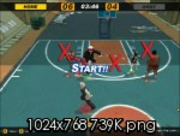
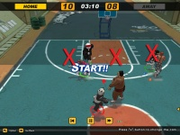
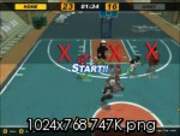



Another thing, do not pass the ball to the SF when he/she is
being surrounded by 2-3 people. If you give him/her the ball at this time, I
guarantee it’ll be a turnover because the SF will try to move with it and get
smacked with 2-3 face ups… so just have patience and wait until the SF is
moving freely, then pass the ball. Actually, you can probably just pass to your
rebounder because he/she will most likely be free under the basket for an easy
basket lol… but this is more of the vision part of playing PG which will be
discussed later. I also suggest you learn your SF’s tendencies and playing
style. You’ll need to know this because it’ll help you anticipate his/her
running pattern and timing so you can pass the ball at the correct moment in
order to maximize kukgi. If the SF gives you back the ball after you passed it
to him/her, this doesn’t mean it’s a signal for you to start spamming A and
shoot 3pters… it probably means the SF rode the pass incorrectly, the ball was
received at the wrong time, he/she pumped fake, a bad pass by you, or he/she is
getting doubled team. When you receive a pass back from the SF, quickly survey the
situation in order to see what to do next. Most likely the SF will want the
ball back. It all depends on who you are playing with. Some people will want
the ball right back after they return your passes and some people will want a
little delay for them to get into position for the next pass. ADAPT TO YOUR SF. Not everyone plays the same so be patient and work with whoever you are playing with.
Techniques: try not to pass the ball using the behind the
back motion, this hurts your SF’s kukgi. You need to face the person you are intending
to pass to and then give them the ball. This way your PG will do an underhand
motion which creates a more fluid pass. The better the pass, the harder it is
for the other team to block your SF. I don’t know if you have noticed but every
time someone rides a behind the back pass to do kukgi, the shot usually gets
blocked.
Why do so many PG’s run in the opposite direction of the SF
at the start of each possession then proceed to throw the ball across the court
using the behind the back motion??? This is just stupid… it doesn’t make you
look cool… it just hurts your teammate. You need to be on the same screen as
the SF if you are going to make a pass… the key point is: “pass if you can see
the SF on your screen, don’t pass if you don’t.” Of course there are times when
you will need to do a further pass, but see below for some examples of how far
you should be from the SF when you pass them the ball:
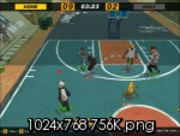
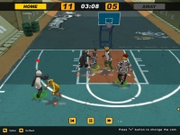
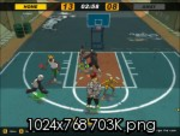
Vision:



Vision:
MISC
Let me repeat myself, MASTER DIVING IN ORDER TO BLOCK
RECOVERY! This habit will help your SF tremendously. Do not run away after
passing the ball to the SF… I hate it when PG’s do this. After passing to the
SF, start heading towards the direction of the shooter in case he/she gets
blocked. What happens if the SF pump fakes and pass the ball to the rebounder?
You will need to immediately spread out. This will create confusion for the
other team and one of you has a good chance to be clear for an open shot. Try
not to stand so close to the SF, give him/her some room to maneuver. Keep your
eye on the SF; if he/she shoots, you are instantly on the way to block recover
if the shot gets blocked; if he/she pumps fake, you promptly run away in the
other direction to stretch the court. Be on alert because some SF after a pump
fake will dribble somewhere else to take a shot, you will probably have to
change direction midway of spreading out to head back to the SF.
As I stated at the start of this guide, if you play this
style of PG you won’t be taking a lot of shots or have any chance to spam A
dribble. Most of your shots will come from mismatches in the defense of the
other team. This also depends a lot on the ability of your SF and rebounder to
pass you the ball when you are open. Unfortunately, many SF’s won’t have the
court vision to pass the ball away to the open man when he/she is getting
doubled team or pass it to the PG for an open shot when the defense is rolling
to their side. Same thing can be said for rebounders who won’t notice that the
PG is open but insist on always passing back to the main scorer. So many times
have I have been standing wide open in the corner for a shot and the rebounder
just passes back to the SF even though the other team is double teaming. So forget about being the main scorer on your team, focus on playing shut down defense and making your teammates better.
***some final thoughts***
- It doesn't really matter if you use a male or female to play my style of PG. However, the male guards seem to be better at shooting the ball.
- I recommend making your character the tallest because it will help out with defense and diving.
- DO NOT spam steal when you are the PG.
- You might have to help out on defense if your other perimeter defender messes up.
- Make sure to know who is the main scorer of your team and mainly passes the ball to him/her.




0 comments:
Post a Comment